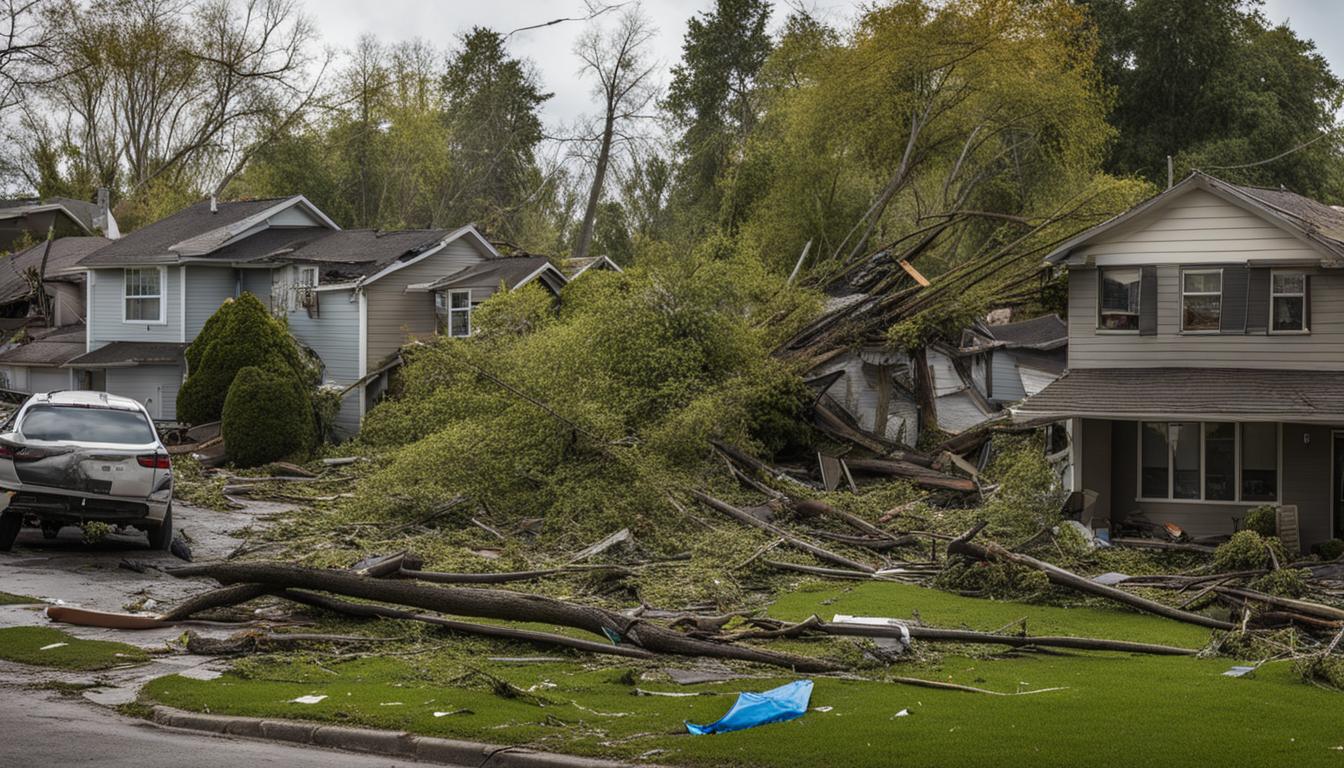Have you ever wondered about the true impact of strong winds? Beyond the gentle breeze that cools us on a hot day, wind can unleash devastating forces that rip through our environment, causing widespread destruction. From structural damage to the erosion of landscapes, the effects of the wind can be far-reaching and often underestimated. So, what are these damaging effects, and how do they impact our daily lives?
Key Takeaways:
- The wind can cause significant damage to structures, ecosystems, and daily life.
- High-speed winds can lead to property damage, economic losses, and even casualties.
- Understanding the effects of the wind is crucial for preparedness and risk mitigation.
Understanding Wind and Its Impact on the Environment
Wind is the movement of air caused by differences in atmospheric pressure. It occurs due to the uneven heating of the Earth’s surface by the sun. Air moves from areas of high pressure to areas of low pressure, creating wind currents. These atmospheric conditions, coupled with the rotation of the Earth, influence wind patterns that can be observed globally.
The strength and direction of the wind can vary depending on geographical factors such as topography, proximity to large bodies of water, and local weather systems. Understanding these wind patterns is essential for predicting and understanding weather changes.
Wind plays a crucial role in driving climate and weather patterns worldwide. It redistributes heat and moisture, affecting temperature and humidity levels. Additionally, wind can transport air pollutants and allergens, influencing air quality.
Moreover, wind is a key factor in the formation of clouds and the process of precipitation. It helps in the transport of moisture, which interacts with other atmospheric conditions to form rain, snow, or other forms of precipitation. Therefore, wind has a direct impact on the distribution of rainfall and the availability of water resources.
Understanding the intricate relationship between wind and weather patterns is essential for meteorologists, climatologists, and scientists studying the Earth’s climate system. It provides valuable insights into how wind influences atmospheric phenomena and helps improve weather forecasting and climate modeling.
Structural Damage Caused by High-Speed Winds
High-speed winds can have a significant impact on the structural integrity of buildings and infrastructure. The force exerted by these winds can potentially lead to severe damage and compromise the stability of structures.
Structural integrity is often compromised due to various factors, including wind pressure, uplift, and lateral forces. These forces can put immense stress on buildings, causing them to sustain significant damage or even collapse.
To minimize the effects of high-speed winds, wind-resistant construction techniques are essential. Reinforced roofs and sturdy foundations are some of the strategies employed to mitigate wind damage. By incorporating these techniques, structures are better equipped to withstand the powerful forces exerted by the wind.
Regular maintenance and inspections are also crucial in identifying weaknesses in structures that are susceptible to wind damage. By proactively detecting vulnerabilities, necessary repairs and reinforcements can be made to enhance the structure’s resistance to wind-related impacts.
Building codes and regulations often include specific requirements for wind-load resistance in areas at high risk of wind damage. These guidelines ensure that structures are constructed to withstand the forces imposed by strong winds, increasing their resilience and safety.
High-speed winds can also have a significant impact on power distribution systems. Strong gusts can disrupt the electrical grid, leading to power outages in affected areas. Fallen trees and debris can damage power lines, poles, and transformers, further exacerbating the situation.
Wind turbines, a source of renewable wind energy, are also vulnerable to damage during severe weather events. To prevent further destruction, wind turbines can be shut down or damaged components repaired after a storm passes.
Utilities often implement strategies to restore power quickly in the aftermath of wind-related disruptions. These measures help in reducing the duration of power outages and minimizing the impact on communities.
The integration of wind power into the electrical grid requires considering wind patterns and reliability. Wind farms are strategically placed in areas with consistent wind resources to maximize energy generation and contribute to the renewable energy goals of a region.
Overall, understanding the potential structural damage caused by high-speed winds is crucial for the development of resilient buildings and infrastructure. By implementing wind-resistant construction techniques, conducting regular inspections, and considering wind patterns in renewable energy strategies, the impact of wind can be minimized, ensuring a safer and more sustainable built environment.
Wind’s Role in Erosion and Landscape Change
Wind plays a significant role in the erosion and shaping of landscapes. The powerful force of wind can remove and transport soil particles, resulting in wind erosion. This process can lead to the formation of sand dunes and the degradation of fertile land.
Desertification, a form of land degradation, is caused by factors such as deforestation, improper land management, and climate change. These factors contribute to wind erosion and the loss of productive soil. To prevent and control wind erosion, various measures can be implemented.
One effective technique is the planting of windbreaks, which are rows of trees or shrubs strategically placed to slow down wind speeds and trap soil particles. These windbreaks act as barriers, preventing the direct impact of high-speed winds on the exposed soil.
Another approach is the use of cover crops—vegetation that covers the soil surface—to protect against wind erosion. Cover crops help hold the soil in place, reducing the potential for erosion caused by wind.
Preventing desertification requires sustainable land use practices and soil conservation. By implementing techniques such as terracing, contour plowing, and the use of organic matter, soil erosion caused by wind can be minimized and degraded land can be rejuvenated.
Coastal areas are particularly vulnerable to erosion caused by a combination of wind and wave action. Intense winds can result in the loss of beaches, dunes, and coastal vegetation, threatening the integrity of coastal ecosystems.
To mitigate wind-induced coastal erosion, protective measures are implemented. These can include the construction of seawalls, which act as barriers to prevent the direct impact of strong winds and waves on coastal land. Additionally, beach nourishment projects involve replenishing beaches with sand to maintain their natural protective barrier against wind erosion.
Climate change and rising sea levels further exacerbate the vulnerability of coastal areas to wind-driven erosion. Understanding wind patterns and their impact on coastal erosion is crucial for effective coastal management and protecting the valuable ecosystems that rely on stable coastlines.
Socioeconomic Consequences of Wind-Related Disasters
Wind-related disasters have significant socioeconomic consequences for communities and infrastructure. The costs of repairing and rebuilding damaged structures and infrastructure can be substantial, impacting local economies and budgets. Disruptions to transportation networks and utilities can hinder economic activities, affecting businesses and livelihoods. In addition, wind-related disasters can result in job losses, displacement of populations, and psychological distress for affected individuals.
Building resilient communities and implementing disaster preparedness measures are essential for mitigating the socioeconomic impacts of wind-related disasters. By investing in hazard mitigation, communities can reduce the damage caused by high winds and enhance their ability to recover quickly. This includes implementing building codes and regulations that prioritize wind-resistant construction techniques and conducting risk assessments to identify vulnerable areas.
When it comes to recovering from wind-related disasters, windstorm insurance plays a crucial role. Homeowner’s insurance policies typically cover windstorms and wind-related damage, providing financial protection for affected individuals and businesses. However, insurance coverage and deductibles may vary depending on geographical location and risk levels. It is essential for homeowners and businesses to understand policy terms, exclusions, and the claims process to ensure proper insurance coverage.
Insurance companies often have specific guidelines and requirements for windstorm mitigation and prevention to minimize their liabilities. Implementing these recommended measures, such as installing storm shutters or reinforcing roofs, can help reduce the risk of wind damage and potentially lower insurance premiums. Proper insurance coverage and financial planning can also help individuals and businesses recover from wind-related losses more effectively.
Overall, acknowledging and addressing the socioeconomic consequences of wind-related disasters is crucial for fostering community resilience and preparedness. By implementing preventive measures, ensuring adequate insurance coverage, and prioritizing disaster recovery efforts, communities can minimize the long-term impacts and promote a more sustainable future.
Conclusion
The damaging effects of the wind extend far beyond physical damage to structures and infrastructure. High-speed winds can also have significant environmental and ecological impacts, leading to erosion and socioeconomic consequences. It is crucial to understand the profound impact of wind and take preventive measures to mitigate risks and build resilient communities.
Continued research and advancements in construction techniques, renewable energy, and disaster preparedness are essential in addressing the damaging effects of the wind. By developing innovative construction methods and technologies, we can create more wind-resistant structures that can withstand high-speed winds and minimize damage. Additionally, investing in renewable energy sources such as wind power can reduce our reliance on fossil fuels and help mitigate the effects of climate change.
Disaster preparedness plays a vital role in minimizing the impacts of wind-related disasters. By implementing early warning systems, educating communities about evacuation plans, and improving emergency response capabilities, we can reduce the loss of life and property. It is also important for individuals and businesses to have comprehensive insurance coverage to aid in recovery efforts.
Overall, recognizing the damaging effects of wind and taking proactive measures can help us adapt to and mitigate the risks associated with strong winds. By prioritizing research, innovation, and community resilience, we can build a more sustainable and secure future in the face of wind-related challenges.









